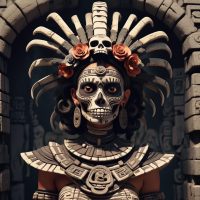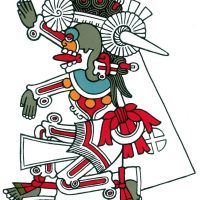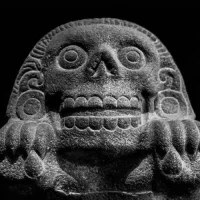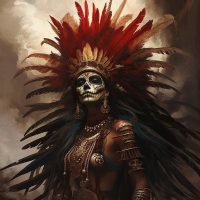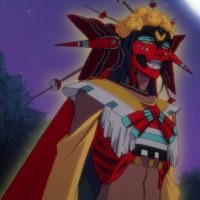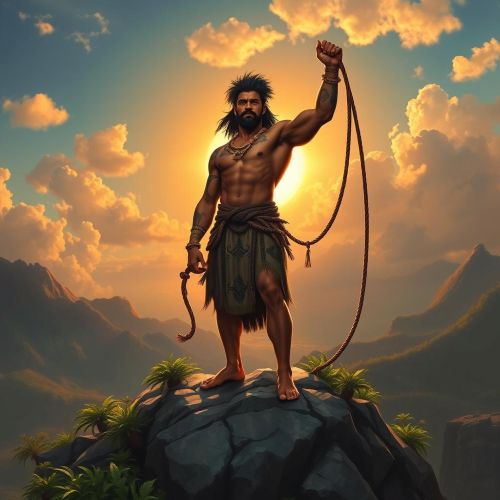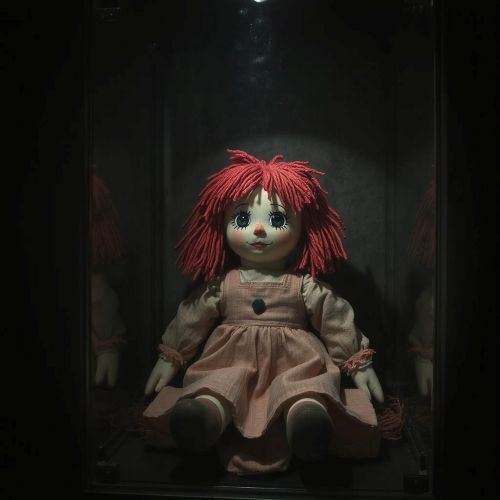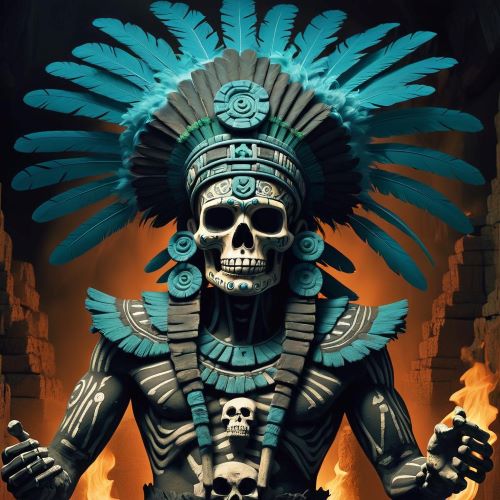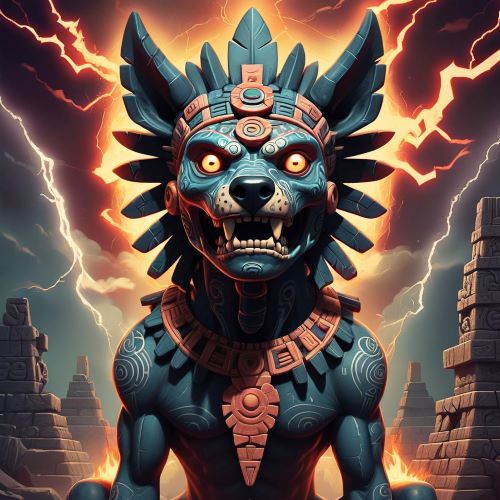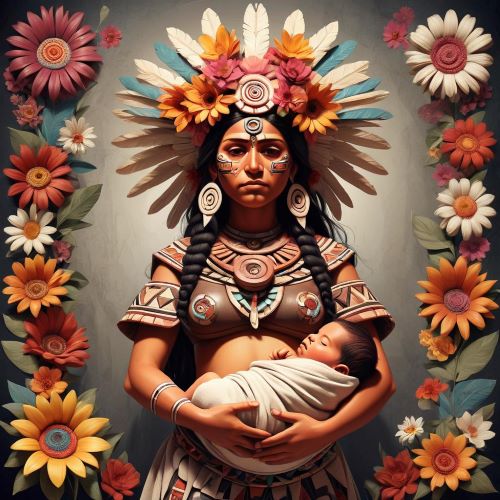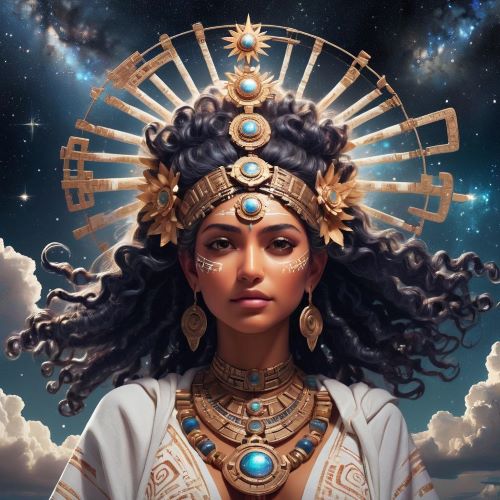Mictecacihuatl : Goddess of Death
Listen
At a glance
| Description | |
|---|---|
| Origin | Aztec Mythology |
| Classification | Gods |
| Family Members | Mictlantecuhtli (Husband) |
| Region | Mexico |
| Associated With | Death, Underworld |
Mictecacihuatl
Introduction
Mictecacihuatl, often addressed as the “Lady of the Dead,” holds a pivotal role in Aztec mythology. She serves as a deity associated with death, partnered with Mictlāntēcutli, the god overseeing Mictlān, the deepest realm of the underworld. Responsible for safeguarding the remains of the departed and presiding over ancient ceremonies dedicated to the deceased, Mictecacihuatl embodies the intricate balance between life and death in Aztec belief. With her title translating to “Lady of the Dead” in the Nahuatl tongue, she commands Mictlan alongside her spouse, Mictlantecuhtli, the ruler of the underworld. Revered for her guardianship of the deceased rather than instilling fear as a harbinger of death, Mictecacihuatl stands as a symbol of respect and authority in the realm of the afterlife.
Physical Traits
Mictecacihuatl’s representations in Aztec mythology are rich with symbolism, reflecting her profound connection to death and the afterlife. Often depicted with a defleshed body and a gaping jaw, she was believed to swallow the stars, rendering them invisible by day. Aztec art portrays her with a skull-like visage, wearing a skirt fashioned from serpents, and with drooping breasts, each element carrying significant meaning. Her flayed skin symbolizes the transience of mortal life, while her open mouth signifies the acceptance of souls into the underworld. Varied depictions highlight her association with death, whether through a skeletal countenance or a raw, flayed form. Her attire, including a skirt of snakes, reinforces her ties to the realm of the dead. Despite her eerie appearance, Mictecacihuatl commands reverence and authority over departed souls, embodying the inevitability and impartiality of death itself.
Family
Mictecacihuatl’s primary familial connection lies with her husband, Miclantecuhtli, with whom she forms a formidable partnership governing Mictlan and orchestrating the destiny of the deceased. While information regarding their offspring remains scarce, some scholars speculate a potential link to Xolotl, the dog-headed deity associated with fire and misfortune, who occasionally guided souls to the afterlife. As the consort of Mictlāntēcutli, Mictecacihuatl shares in the rulership of Mictlan, the underworld realm. Together, they exercise authority over all types of souls, including those who met their end through ordinary means, heroic deeds, or less auspicious circumstances. In Aztec belief, Mictlēcacihuātl and Mictlantecuhtli hold sway over the intricate rituals of death and the journey of souls, wielding immense influence over the afterlife’s intricate workings.
Other names
Though Mictlēcacihuātl is predominantly recognized as the Queen of Mictlan, her presence in Aztec mythology extends through various epithets and titles. One such moniker is Mictecacihuatl, denoting her as the “Lady of the Dead” or the “Lady of the Underworld.” This alternative designation underscores her pivotal role within the realm of the deceased, embodying the very essence of mortality itself. Additionally, she is occasionally known as Tzontémoc, a name emphasizing her profound connection to the passage of time and the transient nature of existence.
Beyond Mictecacihuatl, she assumes other identities, including Mictlánquihuatl, the “Lady of Mictlán,” and Chalmecaquihuatl, the “Lady of the Rope.” While Mictecacihuatl stands as her most renowned title, others offer additional insights into her multifaceted character. For instance, she is also identified as “Chicomecoatl,” translating to “Seven Serpent,” which alludes to her serpent-adorned skirt and her association with the underworld. Furthermore, she may be referred to as “Tlacotlazque,” meaning “Eater of Filth,” a term possibly linked to the concept of decay within the realm of the dead. Each appellation contributes to the rich tapestry of Mictlēcacihuātl’s identity, reflecting the diverse facets of her dominion over death and the afterlife.
Powers and Abilities
Mictecacihuatl wielded an array of powers intertwined with death and the underworld, marking her as a pivotal figure in Aztec mythology. As the guardian of the deceased’s bones and overseer of commemorative festivals, she played a vital role in the afterlife’s rituals. Some accounts even attribute to her the task of gathering bones, facilitating their potential rebirth into the living world. Moreover, she reigned supreme over Mictlan, the shadowy expanse where departed souls dwelled, solidifying her authority in the realm of the dead.
In the intricate tapestry of the afterlife, Mictecacihuatl’s influence transcended mere symbolism, embodying the perpetual cycle of life and death. Revered as the custodian of ancestral connections, she ensured the preservation of spiritual legacies and guided souls on their transcendental journey. Alongside her consort, Miclantecuhtli, she ruled over Mictlan, overseeing the careful guardianship of bones and facilitating their passage to the realms beyond.
As the Queen of Mictlan, Mictlēcacihuātl’s powers were unparalleled, guiding souls through perilous underworld paths to their ultimate destination. She held sway over the Aztec cosmological cycle, orchestrating the perpetual renewal of life through death. Revered in rituals and ceremonies honoring ancestors, her enduring influence permeates both the realm of the living and the realm of the dead.
Modern Day Influence
The influence of Mictecacihuatl extends seamlessly from ancient Aztec traditions to the vibrant festivities of the modern Day of the Dead, a synthesis enriched by Spanish influences. Embracing her role, she presides over contemporary celebrations, intertwining her ancient legacy with evolving cultural practices. Across devoutly Christian Hispanic communities in Mexico, Central America, and beyond, the Day of the Dead pays homage to Mictecacihuatl and Miclantecuhtli, the divine couple who govern the afterlife.
In present-day Mexico, Mictecacihuatl’s imprint on the Day of the Dead remains palpable, deeply rooted in Aztec rituals yet adorned with Catholic overlays. Altars adorned with offerings of food and marigolds, believed to guide souls with their fragrance, serve as poignant tributes to departed loved ones. Amidst these displays, images of Mictecacihuatl and her consort stand sentinel, evoking the mystical realm they once ruled. Beyond the realm of ritual, Mictecacihuatl’s influence permeates Mexican folk art and serves as a wellspring of inspiration for contemporary creators. Her compelling narrative resonates with artists, writers, and musicians alike, offering a nuanced exploration of mortality and the afterlife through the lens of a powerful yet nurturing death goddess.
Yet Mictecacihuatl’s significance transcends Mexico’s borders, captivating broader discussions on death and the divine feminine. As a multifaceted figure embodying both death and renewal, she challenges conventional perceptions of female deities. In an era marked by a burgeoning interest in diverse mythological traditions, Mictecacihuatl emerges as a potent symbol, underscoring the profound complexities inherent in human contemplation of the afterlife, and the enduring influence of goddesses in shaping such understandings.
Related Images
Frequently Asked Questions
What is lorem Ipsum?
I am text block. Click edit button to change this text. Lorem ipsum dolor sit amet, consectetur adipiscing elit. Ut elit tellus, luctus nec ullamcorper mattis, pulvinar dapibus leo.
What is lorem Ipsum?
I am text block. Click edit button to change this text. Lorem ipsum dolor sit amet, consectetur adipiscing elit. Ut elit tellus, luctus nec ullamcorper mattis, pulvinar dapibus leo.
What is lorem Ipsum?
I am text block. Click edit button to change this text. Lorem ipsum dolor sit amet, consectetur adipiscing elit. Ut elit tellus, luctus nec ullamcorper mattis, pulvinar dapibus leo.
What is lorem Ipsum?
I am text block. Click edit button to change this text. Lorem ipsum dolor sit amet, consectetur adipiscing elit. Ut elit tellus, luctus nec ullamcorper mattis, pulvinar dapibus leo.
What is lorem Ipsum?
I am text block. Click edit button to change this text. Lorem ipsum dolor sit amet, consectetur adipiscing elit. Ut elit tellus, luctus nec ullamcorper mattis, pulvinar dapibus leo.

